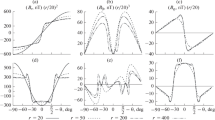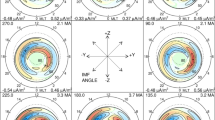Abstract
When the solar wind flows round the magnetosphere, its flow structure and interplanetary magnetic field lines are affected. This indicates the appearance of an electric current system in near-Earth space. the magnetized solar wind plasma moving at the solar wind velocity in the coordinate system of near-earth bow shock induces an electric field in this system. When crossing the bow shock front at the nose point, the tangential magnetic field component increases nearly four times, and the magnetic field energy density—15 times.
This paper relies on the results of earlier researches (Ponomarev et al. 2006a, 2006b), where we obtained the expression for electric current generated in the bow shock front and closed through the magnetosphere, as well as finding the magnetopause potential as a function of solar wind parameters—solar wind velocity and B z -component of the interplanetary magnetic field. The power W consumed by the magnetosphere is equal to the Poynting flux through the magnetopause. According to a special case of Poynting’s theorem, applied to the geomagnetosphere, the energy flux can be expressed through electric potential (integration is over the entire magnetospheric surface). Thus, we obtain the required dependence for W. This dependence appears to be a square law relative to IMF B z -component.








Similar content being viewed by others
References
Balogh et al. (2005) Cluster at the bow shock: introduction. Space Sci Rev 118:155–160
Crooker NU, Siscoe GL, Mullen PR, Russell CT, Smith EJ (1982) Magnetic field compression at the dayside magnetopause. J Geophys Res 87(A12):10407–10412
Leonovich AS (1999) Energy flux of magnetosonic waves from the solar wind into the magnetosphere. Geomagn Aeron 39(2):52–55
Madelung E (1957) Die Mathematischen Hilfsmittel des Physikers. Springer, Berlin
Madelung E (1960) The mathematical apparat of physics. GIFML, Moscow, p 618 (in Russian)
Perreault P, Akasofu S-I (1978) A study of geomagnetic storms. Geophys J R Astron Soc 54:547–551
Ponomarev EA (1985) Mechanisms of magnetospheric substorms, M. Nauka, Moscow, p 157 (in Russian)
Ponomarev EA, Sedykh PA, Urbanovich VD (2006a) Bow shock as a power source for magnetospheric processes. J Atmos Sol-Terr Phys 68:685–690
Ponomarev EA, Sedykh PA, Urbanovich VD (2006b) Generation of electric field in the magnetosphere, caused by processes in the bow shock. J Atmos Sol-Terr Phys 68:679–684
Pudovkin MI, Kozelov VP, Lazutin LL, Troshichev OA, Chertkov AD (1977) Physical basis of magnetospheric disturbance forecasting, L. Nauka, Moscow, p 312 (in Russian)
Santolik O, Sedykh P, Wang X, Kakad A, Tang R, Zhou X, Huang Z (2004) Case studies of wave phenomena in the earth’s bow shock region. In: 3rd regional COSPAR workshop. Beijing, pp 10–14
Sedykh PA (2011) The relief of plasma pressure and generation of field-aligned currents in the magnetosphere. Astron Astrophys 1:15–24. ISSN 2161-4725
Sedykh PA, Ponomarev EA (2002) Magnetosphere-ionosphere coupling in the region of auroral electrojets. Geomagn Aeron 42(5):582–587
Sedykh PA, Ponomarev EA (2012) A structurally adequate model of the geomagnetosphere. Stud Geophys Geod 56:1079–1093. doi:10.1007/s11200-011-9027-3
Whang YC (1987) Slow shocks and their transition to fast shocks in the inner solar wind. J Geophys Res 92(5):4349–4356
Author information
Authors and Affiliations
Corresponding author
Appendix: Parabolic system of coordinates; in terms of Madelung (1957, 1960)
Appendix: Parabolic system of coordinates; in terms of Madelung (1957, 1960)
-
In general case:
$$\frac{u + iv}{\sqrt{2}} = \sqrt{z + i\rho}\quad \bigl(\rho = \sqrt{x^{2} + y^{2}}\bigr) $$$$u^{2} = r + z,\quad \mbox{where}\ r = \sqrt{z^{2} + \rho^{2}},\ x = uv\cos (\varphi ),\ 0 \le u \le \infty $$$$v^{2} = r - z,\qquad y = uv\sin (\varphi ),\quad 0 \le v \le \infty $$$$\varphi = \arctan \frac{y}{x},\qquad z = \frac{u^{2} - v^{2}}{2},\quad 0 \le \varphi \le 2\pi $$$$\rho = uv,\qquad r = \frac{u^{2} + v^{2}}{2},\qquad\frac{\partial u}{\partial \rho} = \frac{1}{2u}\frac{\rho}{r},\qquad \frac{\partial v}{\partial p}=\frac{1}{2v}\frac{\rho}{r},\qquad \frac{\partial u}{\partial z} = \frac{\partial v}{\partial \rho}. $$ -
Linear element:
$$ds^{2} = \bigl(u^{2} + v^{2}\bigr) \bigl(du^{2} + dv^{2}\bigr) + u^{2}v^{2}d \varphi^{2}. $$$$D = \frac{1}{u^{2} + v^{2}} = \frac{1}{2r}. $$ -
Element of volume:
$$dV = uv\bigl(u^{2} + v^{2}\bigr)dudvd\varphi. $$ -
Vector components:
$$a_{u} = \frac{a_{x}x + a_{y}y}{\sqrt{2r(r + z)}} + a_{z}\sqrt{\frac{r + z}{2r}},\qquad a_{x} = \frac{a_{u}v + a_{v}u}{\sqrt{u^{2} + v^{2}}} \cos (\varphi ) - a_{\varphi} \sin (\varphi ), $$$$a_{v} = \frac{a_{x}x + a_{y}y}{\sqrt{2r(r - z)}} - a_{z}\sqrt{\frac{r - z}{2r}},\qquad a_{y} = \frac{a_{u}v + a_{v}u}{\sqrt{u^{2} + v^{2}}} \sin (\varphi ) + a_{\varphi} \cos (\varphi ), $$$$a_{\varphi} = \frac{ - a_{x}y + a_{y}x}{\sqrt{x^{2} + y^{2}}},\qquad a_{z} = \frac{a_{u}u - a_{v}v}{\sqrt{u^{2} + v^{2}}}. $$Then:
$$\operatorname{grad}_{u}\psi = \frac{1}{\sqrt{u^{2} + v^{2}}} \frac{\partial \psi}{\partial u},\qquad \operatorname{grad}_{v}\psi = \frac{1}{\sqrt{u^{2} + v^{2}}} \frac{\partial \psi}{\partial v},\qquad \operatorname{grad}_{\varphi} \psi = \frac{1}{uv}\frac{\partial \psi}{\partial \varphi} $$$$\operatorname{div}\mathrm{A} = \frac{1}{\sqrt{u^{2} + v^{2}}} \biggl\{ \frac{1}{u} \frac{\partial}{\partial u}(ua_{u}) + \frac{1}{v}\frac{\partial}{\partial v}(va_{v}) + \sqrt{\frac{1}{u^{2}} + \frac{1}{v^{2}}} \frac{\partial a_{\varphi}}{\partial \varphi} + \frac{ua_{u} + va_{v}}{u^{2} + v^{2}} \biggr\} , $$$$\Delta \psi = \frac{1}{u^{2} + v^{2}} \biggl\{ \frac{1}{u}\frac{\partial}{ \partial u} \biggl(u\frac{\partial \psi}{\partial u}\biggr) + \frac{1}{v}\frac{\partial}{\partial v}\biggl(v \frac{\partial \psi}{\partial v}\biggr) + \biggl( \frac{1}{u^{2}} + \frac{1}{v^{2}} \biggr) \frac{\partial^{2}\psi}{ \partial \varphi^{2}} \biggr\} $$$$\operatorname{curl}_{u}A = \frac{1}{v\sqrt{u^{2} + v^{2}}} \frac{\partial}{\partial v}(va_{\varphi} ) - \frac{1}{uv}\frac{\partial a_{v}}{\partial \varphi}, $$$$\operatorname{curl}_{v}A = \frac{1}{uv}\frac{\partial a_{u}}{\partial \varphi} - \frac{1}{u\sqrt{u^{2} + v^{2}}} \frac{\partial}{\partial u}(ua_{\varphi} ), $$$$\operatorname{curl}_{\varphi} A = \frac{1}{\sqrt{u^{2} + v^{2}}} \biggl\{ \biggl( \frac{\partial a_{v}}{\partial u} - \frac{\partial a_{u}}{\partial v} \biggr) + \frac{ua_{v} - va_{u}}{u^{2} + v^{2}} \biggr\} $$
Rights and permissions
About this article
Cite this article
Sedykh, P.A. Transformation of solar wind energy into the energy of magnetospheric processes. Acta Geod Geophys 49, 1–15 (2014). https://doi.org/10.1007/s40328-013-0036-2
Received:
Accepted:
Published:
Issue Date:
DOI: https://doi.org/10.1007/s40328-013-0036-2




